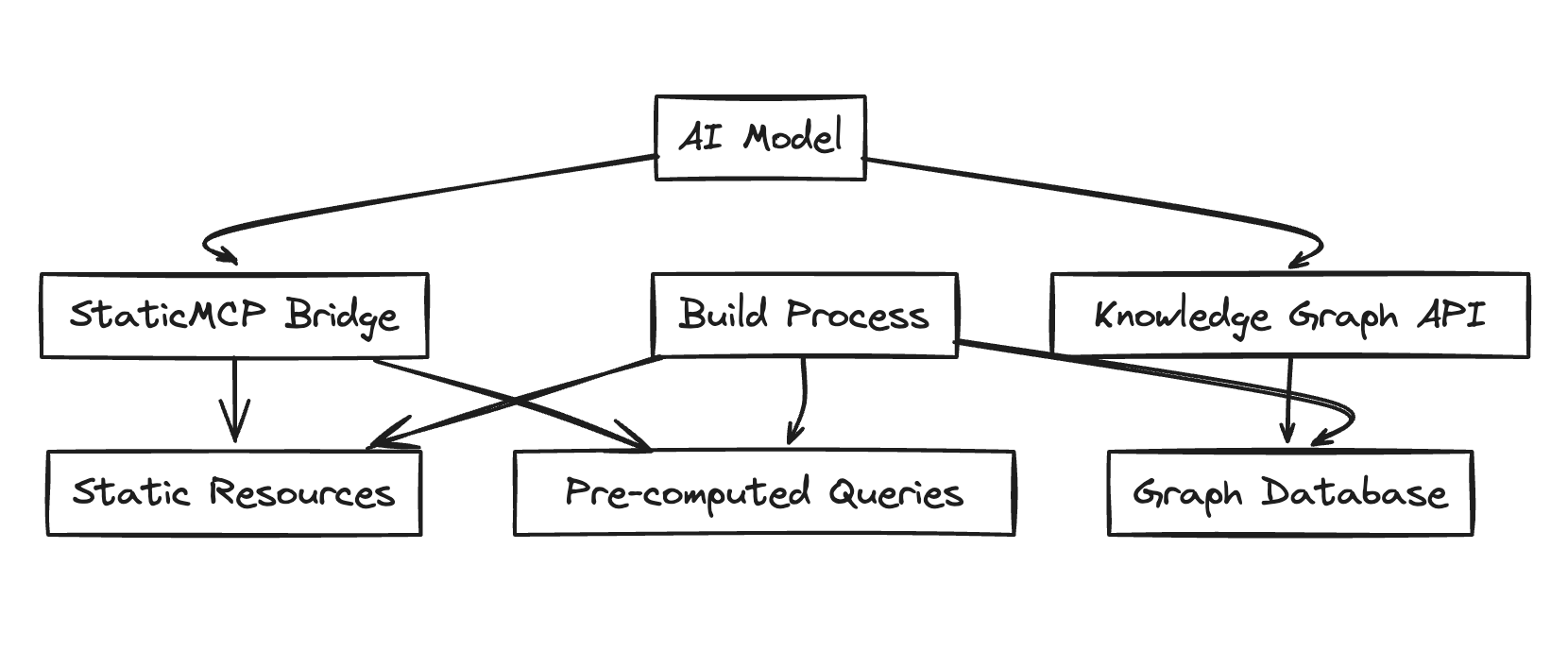Alternatives
When evaluating StaticMCP, it's important to understand how it differs from other approaches to serving information to AI models. Let's explore the key distinctions.
StaticMCP vs Regular Static HTML Sites
While both involve serving static files, they serve fundamentally different purposes and audiences.
Static HTML Sites
- Purpose: Human consumption through web browsers
- Interface: Visual presentation with HTML, CSS, JavaScript
- Navigation: Click-through links, search boxes, menus
- Content Structure: Optimized for reading flow and visual hierarchy
- Interaction: Form submissions, user events, DOM manipulation
StaticMCP
- Purpose: AI model consumption through structured APIs
- Interface: Machine-readable JSON with standardized schemas
- Navigation: Programmatic resource and tool calls
- Content Structure: Optimized for semantic understanding and querying
- Interaction: Function calls with parameters and structured responses
Key Technical Differences
| Aspect | Static HTML | StaticMCP |
|---|---|---|
| Data Format | HTML/CSS/JS | JSON with MCP schemas |
| Access Pattern | HTTP GET requests | JSON-RPC over HTTP |
| Content Discovery | Sitemaps, crawling | Manifest-driven capabilities |
| Parameterization | Query strings, forms | Tool parameters, resource URIs |
| Response Structure | Unstructured content | Standardized MCP responses |
Practical Example
Static HTML approach:
<!-- search.html -->
<h1>Search Results for "Python"</h1>
<div class="result">
<h3>Python Tutorial</h3>
<p>Learn Python programming basics...</p>
</div>
StaticMCP approach:
// tools/search/python.json
{
"staticmcp": {
"type": "tool",
"parameters": {"query": "python"}
},
"content": [{
"type": "text",
"text": "Found 3 Python resources:\n1. Python Tutorial - Learn Python programming basics\n2. Advanced Python - Object-oriented concepts\n3. Python Web Development - Flask and Django"
}]
}
The HTML is designed for human eyes and browser rendering, while StaticMCP provides structured, semantic data that AI models can directly process and reason about.
StaticMCP vs Knowledge Graphs
Knowledge graphs and StaticMCP serve related but distinct purposes in the AI context ecosystem.
Knowledge Graphs
- Purpose: Represent relationships between entities as interconnected data
- Structure: Nodes (entities) connected by edges (relationships)
- Query Language: SPARQL, Cypher, or custom graph traversal
- Strength: Complex reasoning over relationships and inference
- Storage: Graph databases (Neo4j, Amazon Neptune, etc.)
StaticMCP
- Purpose: Provide standardized access to tools and resources
- Structure: Discrete resources and parameterized function calls
- Query Language: MCP JSON-RPC protocol
- Strength: Simple, cacheable, web-native deployment
- Storage: Static JSON files on any web server
Complementary Use Cases
These approaches often work better together than in competition:
Knowledge Graph Strengths:
- "What are all the dependencies of Python package X?"
- "Find all papers by authors who collaborated with researchers at Stanford"
- "What's the relationship between concept A and concept B?"
StaticMCP Strengths:
- "Get the contents of this specific document"
- "Search for items matching this query"
- "Execute this tool with these parameters"
- "What resources are available in this context?"
Hybrid Architecture Example
You might use both in a comprehensive AI system:

StaticMCP handles:
- Document retrieval:
resources/readfor specific files - Search results:
tools/searchwith pre-computed responses - Simple lookups: Common queries pre-generated as static files
Knowledge Graph handles:
- Complex reasoning: "Find indirect relationships between X and Y"
- Dynamic queries: Novel questions requiring graph traversal
- Inference: Deriving new facts from existing relationships
Performance and Cost Comparison
| Factor | Static HTML | StaticMCP | Knowledge Graph |
|---|---|---|---|
| Latency | ~10ms (CDN) | ~10ms (CDN) | ~100-1000ms (DB query) |
| Throughput | Very High | Very High | Medium |
| Infrastructure Cost | $0-5/month | $0-5/month | $100-1000s/month |
| Query Complexity | Low | Medium | Very High |
| Reasoning Capability | None | Limited | Extensive |
When to Choose What
Choose Static HTML when:
- Building websites for human consumption
- Need rich visual presentation
- Interactive user interfaces are primary goal
Choose StaticMCP when:
- Serving structured data to AI models
- Content is relatively stable (updates hourly/daily)
- Need maximum performance and minimum cost
- Want to leverage CDN caching globally
- Building tools, document access, or search capabilities
Choose Knowledge Graphs when:
- Complex relationships are central to your use case
- Need real-time inference and reasoning
- Data is highly interconnected
- Supporting novel queries that can't be pre-computed
- Building recommendation engines or discovery systems
Choose Hybrid Approach when:
- Need both fast access to static content AND complex reasoning
- Want to optimize common queries (StaticMCP) while supporting arbitrary queries (KG)
- Building comprehensive AI systems with multiple data access patterns
Real-World Scenarios
Scenario 1: Personal AI Assistant
- StaticMCP: Resume, project list, personal documents, skills inventory
- Knowledge Graph: Relationships between projects, skills, experiences, career progression
Scenario 2: Company Documentation
- Static HTML: Public website for human visitors
- StaticMCP: API docs, code examples, FAQ responses for AI consumption
- Knowledge Graph: Internal relationships between teams, products, technologies
Scenario 3: Research Database
- StaticMCP: Paper abstracts, author profiles, cached search results
- Knowledge Graph: Citation networks, collaboration patterns, topic relationships
Architecture Decision Framework
When designing an AI context system, consider:
- Query Predictability: Can you pre-compute most responses? → StaticMCP
- Relationship Complexity: Do you need to traverse complex connections? → Knowledge Graph
- Update Frequency: Does data change multiple times per day? → Dynamic system
- Cost Sensitivity: Is minimizing infrastructure cost important? → StaticMCP
- Performance Requirements: Do you need sub-10ms responses? → StaticMCP
- Human vs AI Consumption: Who is the primary audience? → HTML vs StaticMCP
The key insight is that StaticMCP occupies a sweet spot between simple static sites (too unstructured for AI) and complex knowledge graphs (too expensive/complex for many use cases). It provides AI-optimized structure while maintaining the deployment simplicity and performance characteristics of static web hosting.